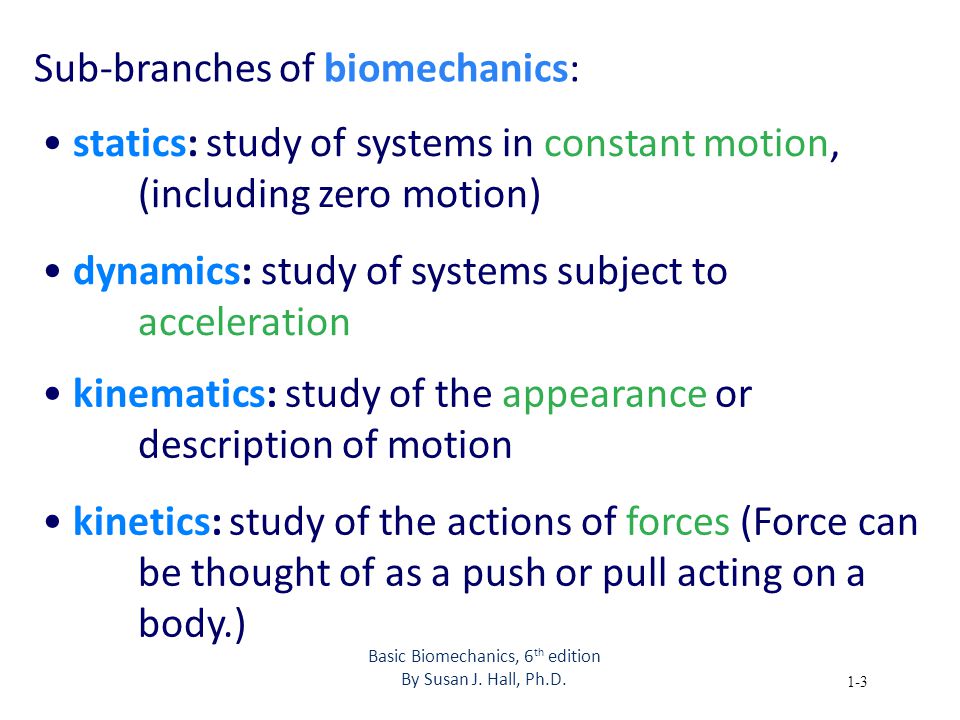Basic biomechanics. [Susan J Hall This introduction to biomechanics uses the latest findings from the research literature to support and exemplify the concepts presented. Quantitative as well as qualitative examples of problems. Basic Biomechanics Mechanicsstudy of forces and motions produced by their action. Biomechanicsapply that to the structure and function of the human body. A free PowerPoint PPT presentation (displayed as a Flash slide show) on PowerShow. com id: 486b68NGUxZ Basic Biomechanics provides an introduction to biomechanics using the latest findings from the research literature to support and exemplify the concepts presented. Quantitative as well as qualitative examples of problems illustrate biomechanical principles. Advanced search allows to you precisely focus your query. Search within a content type, and even narrow to one or more resources. You can also find results for a single author or contributor. Presents the quantitative aspects of biomechanics in a manageable, progressive fashion, with practical advice on approaching both qualitative and quantitative problems in biomechanics. Five important components of biomechanics are featured in this video, including motion, force, momentum, levers and balance. Coaches need to understand these The scientific study of the role of mechanics in biological systems. The study of biomechanics includes the analysis of motion in animals, the fluid dynamics of blood, and the role of mechanical processes in the development of disease. A look at Newton's 3 laws as well as understanding motion and force. Basic Biomechanics of Kuntao Basic Biomechanics of Kuntao, or BBK, is the second of a six course progression in intuitive unarmed defense teaching how to move safely, the mentality and skills to respond efficiently to a threat at or within two arms reach, for protection and overall general wellbeing. The major goal of the edition is to make the text more practical and relevant for today's students of biomechanics. The approach taken involves a balance of qualitative and quantitative examples and problems designed to illustrate the biomechanical principles discussed. The following ten principles of biomechanics provide a solid basis for looking at performance, whether its coaching, teaching, rehabilitation, teaching a kid in the driveway, or watching a sporting event on TV. You can think of these principles as a list for quick reference. BASIC BIOMECHANICS It is important when learning about how the body moves (kinesiology) to also learn about the forces placed on the body that cause the movement. Lippert, p93 Now in its Fourth Edition, Basic Biomechanics of the Musculoskeletal System uses a direct and comprehensive approach to present students with a working. Now in its Fourth Edition, Basic Biomechanics of the Musculoskeletal System uses a direct and comprehensive approach to present students with a working. Chapter 8 The Biomechanics of the Human Lower Extremity Basic Biomechanics, 6th edition By Susan J. Structure of the Hip What is the hip joint? Basic Biomechanics, 6th edition By Susan J. Structure of the Foot The plantar fascia. Lateral view Plantar view Plantar fascia Learn basic biomechanics with free interactive flashcards. Choose from 500 different sets of basic biomechanics flashcards on Quizlet. The seventh edition of Basic Biomechanics has been significantly updated from the previous edition. The approach taken remains an integrated balance of qualitative and quantitative examples, applications, and problems designed to illustrate the principles discussed. The answers to these questions are all based on the science of biomechanics. In Basic Biomechanics, Eighth Edition, the focus is on the anatomy and movement capabilities of the human body, explained with examples of relevant sport, clinical, and daily living applications. OS 203: Skin, Muscles and Bones. BASIC BIOMECHANICS OF MUSCULOSKELETAL SYSTEM JULY8, 2011 Dr. Rafael Bundoc 2 Functions of the Skeletal System EMBED (for wordpress. org item description tags) Introduction to Biomechanics: Basic Biomechanics of the Foot Terminology and Concepts 2 and Ankle 222 Niha! James Sammarco, Ross Todd Hockenbury Biomechanics is a fascinating field. Possessing sufficient knowledge in this area is paramount for properly understanding resistance training. I try my best to educate my readers so that over time they can build upon their knowledge and reach superior levels of understanding with regards to human. Basic Biomechanics In Orthopaedics BBiOrth Course. Basic Biomechanics in Orthopaedics (BBiOrth) is a oneday course held at The Royal The basic mechanical principles which govern how the hip joint maintains equilibrium and balance during standing and performing activities is explained along with. In Basic Biomechanics, Eighth Edition, the focus is on the anatomy and movement capabilities of the human body, explained with examples of relevant sport, clinical, and daily living applications. The quantitative aspects of biomechanics are presented in a manageable, progressive fashion, using a structured and problembased format with. Were committed to providing you with highvalue course solutions backed by great service and a team that cares about your success. The seventh edition of Basic Biomechanics has been significantly updated from the previous edition. The approach taken remains an integrated balance of qualitative and quantitative examples, applications, and problems designed to illustrate the principles discussed. Joint Anatomy and Basic Biomechanics OUTLINE 3 From: Harmony Medical. applied by muscles at some point along the lever to move the body part (resistance). The lever is one of the simplest of all mechanical devices that can be called a machine. The relationship of fulcrum to force to resistance Unique in its direct and comprehensive approach, this Third Edition presents a working knowledge of biomechanical principles for use in the evaluation and treatment of musculoskeletal dysfunction. Three sections address the biomechanics of musculoskeletal tissues and structures, the biomechanics of all human joints, and applied biomechanics. The seventh edition of Basic Biomechanics has been significantly updated from the previous edition. The approach taken remains an integrated balance of qualitative and quantitative examples, applications, and problems designed to illustrate the principles discussed. Basic Biomechanics Over the years there has been an abundance of different theories and concepts as to how to best treat orthopedic patients and athletes. With so many different approaches to assessment and treatment it is easy to get overwhelmed. The seventh edition of Basic Biomechanics has been significantly updated from the previous edition. The approach taken remains an integrated balance of qualitative and quantitative examples applications and problems designed to illustrate the principles discussed. Basic Biomechanics 7th Edition pdf The seventh edition of Basic Biomechanics has been significantly updated from the previous edition. The approach taken remains an integrated balance of qualitative and quantitative examples, applications, and problems designed to illustrate the principles discussed. Biomechanics is the study of the body in motion. Foot biomechanics studies the relationship of the foot to the lower leg. During walking and running the musculoskeletal system generates forces. The seventh edition of Basic Biomechanics has been significantly updated from the previous edition. The approach taken remains an integrated balance of qualitative and quantitative examples, applications, and problems designed to illustrate the principles discussed. The wrist is a complex joint that serves as the link between the forearm and hand and is critical for many upper extremity movements. An understanding of wrist anatomy allows for appreciation of the biomechanics of wrist movement, which helps the clinician to understand injury patterns, perform an. Basic Biomechanics Biomechanics is the study of the body in motion. Foot biomechanics studies the relationship of the foot to the lower leg. During walking and running the musculoskeletal system generates forces to propel the Biomechanics is a combination of two words, which in unison refer to the study of the mechanical laws concerned to the movement of living organisms. Mechanics Dynamicsmoving systems Kinetics examines the forces acting on the body during movement and the motion with respect to time and forces Kinematics A branch of biomechanics that describes the motion of a body without regard to the forces that produce the motion Basic Units 25 NINE FUNDAMENTALS OF BIOMECHANICS 29 Principles and Laws 29 Nine Principles for Application of Biomechanics 30 QUALITATIVE ANALYSIS 35 This second edition of Fundamentals of Biomechanics was developed primarily to update a wellreceived text. The uniqueness of integrating biological and mechani Biomechanics is the study of the structure and function of the mechanical aspects of biological systems, at any level from whole organisms to organs, cells. Basic Biomechanics: With Dynamic Human CDRom and Powerweb 1 Jul 2002. 01 (10 used new offers) 5 out of 5 stars 3. Basic Biomechanics (McGrawHill International Editions Series) 1 May 1999. The seventh model of Basic Biomechanics has been significantly updated from the sooner model. The technique taken stays an constructedin stability of qualitative and quantitative examples, functions, and points designed for instance the principles talked about. Find great deals on eBay for basic biomechanics. Basic Biomechanics and Biomechanical Methods for Experimental Research of the Musculoskeletal System The aim of this workshop is to train clinicians and. The seventh edition of Basic Biomechanics has been significantly updated from the previous edition. The approach taken remains an integrated balance of qualitative and quantitative examples, applications, and problems designed to illustrate the principles discussed. Basic Concepts Biomechanics of the musculoskeletal system r quires a good understanding of basic mechanic The basic terminology and concepts from mechan ics and physics arc utilized to clcscribe intcrn forces of the human body. A lever is a rigid object that is used with an axis to either multiply the mechanical force (effort) or resistance force (load) applied to it. The efficiency of the lever is called mechanical advantage (MA). 6 responses to Basic Biomechanics: Levers. Learn final exam basic biomechanics with free interactive flashcards. Choose from 500 different sets of final exam basic biomechanics flashcards on Quizlet..











